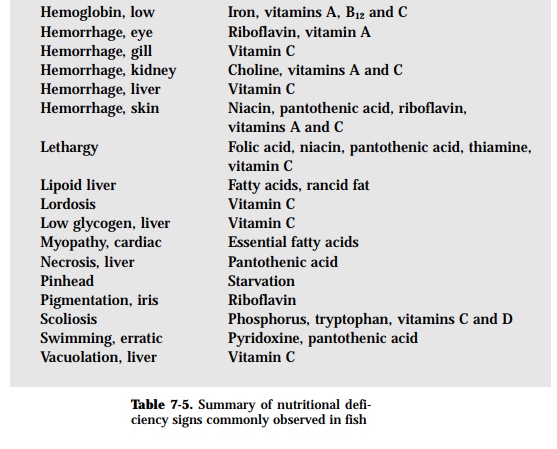Chapter: Health Management in Aquaculture: Nutritional diseases
Nutritional deficiency diseases of fish
NUTRITIONAL DEFICIENCY DISEASES OF FISH
Deficiency diseases in fish occur when the tissue reserves have been depleted and the dietary supply of any necessary nutrient falls below the level that sup-ports optimum nutritional status. Table 7-5 shows the common deficiency signs observed in fish. It is important to realize that by the time signs of nutritional deficiency are visible, fish have usually stopped eating, and feeding fortified diets will not completely reverse the condition in the fish population and pre-vent losses. Several pathological syndromes have been reported in fish.


Amino acid deficiency syndrome
Like other deficiency diseases, diagnosis of malnutrition involving protein or amino acid deficiencies is extremely difficult because many indications of defi-ciency are non-specific. Many of the same diagnostic findings noted in protein and amino acid deficiency are similar to physical and functional alterations found in the diagnosis of diseases caused by other etiological agents. Probably themost common sign of protein and/or amino acid deficiency in fishes is reduction or cessation of growth. Limiting even one indispensable amino acid will affect growth. Feeding a diet in which an essential amino acid has been removed will cause growth to cease until the amino acid is restored to the diet.
Fats and lipids deficiency
Among the clinical features manifested by fish with essential fatty acid defi-ciency are depigmentation, fin erosion, cardiac myopathy and fatty infiltration of the liver. Lipoid liver disease is usually seen in fish fed on trash fish or pelleted diets in which part of the lipid component has gone rancid. Rancid lipids react with protein to lower its biological value and have a deleterious effect on those vitamins which are not themselves antioxidants. Fish suffering from lipoid liver disease have extreme anemia (manifested by pallor of the gills), bronzed rounded heart and a swollen liver with rounded edges.
Vitamin imbalances
Depletion of the body storage of any single vitamin can be responsible for spe-cific or general disease signs. Disease signs and gross pathology usually suggest which vitamin may be deficient, and other diagnostic procedures are then used to complete the diagnosis. Results of research in which specific vitamins have been reduced or eliminated from the diets of fishes have demonstrated the usual signs, gross pathology and histopathology to be expected from specific vitamin deficiency (Table 7-5). Nutritional myopathy syndrome in cultured fishes in Japan is a disease characterized by necrosis and degeneration of the lateral musculature of fish. It has been associated with vitamin E deficiency and with lipid peroxides in the diet. Supplementation of vitamin E was con-firmed to prevent myopathic changes in carp.
Mineral deficiencies
Mineral deficiency studies with fishes are difficult because all traces of eachmineral to be studied must be removed from both food and water. Thus, only a limited number of mineral deficiencies are known or have been studied in fishes. The role of calcium, potassium, and magnesium in bone and joint me-tabolism is well recognized and there is evidence that imbalances or deficien-cies of these can result in spinal abnormalities which leave the fish deformed thereafter.
Related Topics